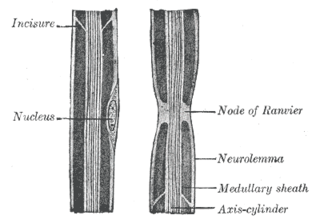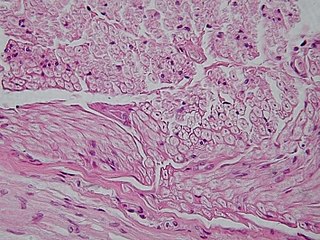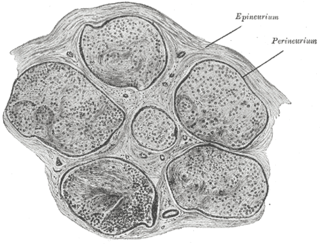This article provides insufficient context for those unfamiliar with the subject.(October 2009) (Learn how and when to remove this template message) |
| Myelin incisure | |
|---|---|
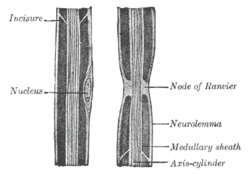 Diagram of longitudinal sections of medullated nerve fibers. (Incisure labeled at upper left.) | |
| Details | |
| System | Nervous system |
| Identifiers | |
| TH | H2.00.06.2.03015 |
| Anatomical terms of microanatomy | |
Myelin incisures (a.k.a. Schmidt-Lanterman clefts, Schmidt-Lanterman incisures, clefts of Schmidt-Lanterman, segments of Lanterman, medullary segments), are small pockets of cytoplasm left behind during the Schwann cell myelination process. They are histological evidence of the small amount of cytoplasm that remains in the inner layer of the myelin sheath created by Schwann cells wrapping tightly around an axon (nerve fiber).

In cell biology, the cytoplasm is all of the material within a cell, enclosed by the cell membrane, except for the cell nucleus. The material inside the nucleus and contained within the nuclear membrane is termed the nucleoplasm. The main components of the cytoplasm are cytosol – a gel-like substance, the organelles – the cell's internal sub-structures, and various cytoplasmic inclusions. The cytoplasm is about 80% water and usually colorless.
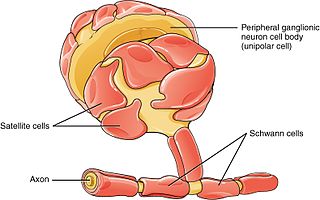
Schwann cells or neurolemmocytes are the principal glia of the peripheral nervous system (PNS). Glial cells function to support neurons and in the PNS, also include satellite cells, olfactory ensheathing cells, enteric glia and glia that reside at sensory nerve endings, such as the Pacinian corpuscle. The two types of Schwann cells are myelinating and nonmyelinating. Myelinating Schwann cells wrap around axons of motor and sensory neurons to form the myelin sheath. The Schwann cell promoter is present in the downstream region of the human dystrophin gene that gives shortened transcript that are again synthesized in a tissue-specific manner.

Histology, also microanatomy, is the branch of biology which studies the tissues of animals and plants using microscopy. It is commonly studied using a light microscope or electron microscope, the specimen having been sectioned, stained, and mounted on a microscope slide. Histological studies may be conducted using tissue culture, where live animal cells are isolated and maintained in an artificial environment for various research projects. The ability to visualize or differentially identify microscopic structures is frequently enhanced through the use of staining. Histology is one of the major preclinical subjects in medical school. Medical students are expected to be familiar with the morphological features and function of all cells and tissues of the human body from an early stage of their studies, so histology often stretches over several semesters.
In the peripheral nervous system (PNS) axons can be either myelinated or unmyelinated. Myelination refers to the insulation of an axon with concentric surrounding layers of lipid membrane (myelin) produced by Schwann cells. These layers are generally uniform and continuous, but due to imperfect nature of the process by which Schwann cells wrap the nerve axon, this wrapping process can sometimes leave behind small pockets of residual cytoplasm displaced to the periphery during the formation of the myelin sheath. These pockets, or "incisures", can subdivide the myelinated axon into irregular portions. These staggered clefts also provide communication channels between layers by connecting the outer collar of cytoplasm of the Schwann cell to the deepest layer of myelin sheath. Primary incisures which appear ab initio in myelination and always extend across the whole radial thickness of the myelin sheath but initially around only part of its circumference. Secondary incisures appear later, in regions of a compact myelin sheath, initially traversing only part of its radial thickness but commonly occupying its whole circumference. [1]

The peripheral nervous system (PNS) is one of two components that make up the nervous system of bilateral animals, with the other part being the central nervous system (CNS). The PNS consists of the nerves and ganglia outside the brain and spinal cord. The main function of the PNS is to connect the CNS to the limbs and organs, essentially serving as a relay between the brain and spinal cord and the rest of the body. Unlike the CNS, the PNS is not protected by the vertebral column and skull, or by the blood–brain barrier, which leaves it exposed to toxins and mechanical injuries.

In biology and biochemistry, a lipid is a biomolecule that is soluble in nonpolar solvents. Non-polar solvents are typically hydrocarbons used to dissolve other naturally occurring hydrocarbon lipid molecules that do not dissolve in water, including fatty acids, waxes, sterols, fat-soluble vitamins, monoglycerides, diglycerides, triglycerides, and phospholipids.

Myelin is a lipid-rich (fatty) substance formed in the central nervous system (CNS) by glial cells called oligodendrocytes, and in the peripheral nervous system (PNS) by Schwann cells. Myelin insulates nerve cell axons to increase the speed at which information travels from one nerve cell body to another or, for example, from a nerve cell body to a muscle. The myelinated axon can be likened to an electrical wire with insulating material (myelin) around it. However, unlike the plastic covering on an electrical wire, myelin does not form a single long sheath over the entire length of the axon. Rather, each myelin sheath insulates the axon over a single section and, in general, each axon comprises multiple long myelinated sections separated from each other by short gaps called Nodes of Ranvier. Each myelin sheath is formed by the concentric wrapping of an oligodendrocyte or Schwann cell process around the axon.



